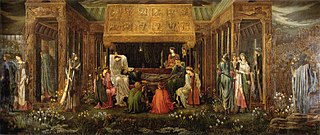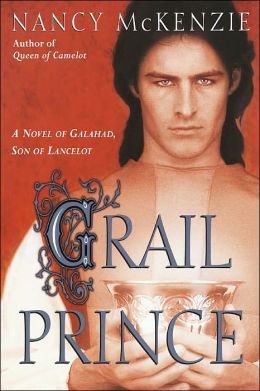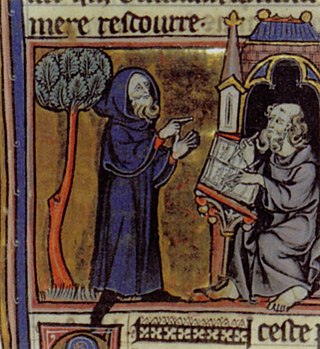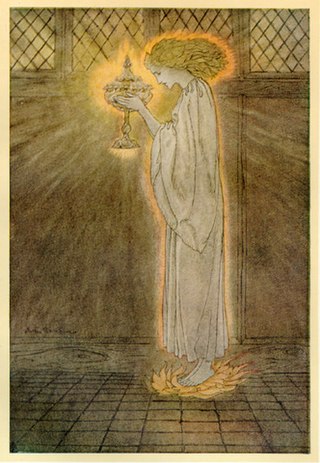
The Holy Grail is a treasure that serves as an important motif in Arthurian literature. Various traditions describe the Holy Grail as a cup, dish, or stone with miraculous healing powers, sometimes providing eternal youth or sustenance in infinite abundance, often guarded in the custody of the Fisher King and located in the hidden Grail castle. By analogy, any elusive object or goal of great significance may be perceived as a "holy grail" by those seeking such.

King Arthur is a legendary king of Britain, and a central figure in the medieval literary tradition known as the Matter of Britain.

The Round Table is King Arthur's famed table in the Arthurian legend, around which he and his knights congregate. As its name suggests, it has no head, implying that everyone who sits there has equal status, unlike conventional rectangular tables where participants order themselves according to rank. The table was first described in 1155 by Wace, who relied on previous depictions of Arthur's fabulous retinue. The symbolism of the Round Table developed over time; by the close of the 12th century it had come to represent the chivalric order associated with Arthur's court, the Knights of the Round Table.

Edward III, also known as Edward of Windsor before his accession, was King of England from January 1327 until his death in 1377. He is noted for his military success and for restoring royal authority after the disastrous and unorthodox reign of his father, Edward II. Edward III transformed the Kingdom of England into one of the most formidable military powers in Europe. His fifty-year reign was one of the longest in English history, and saw vital developments in legislation and government, in particular the evolution of the English Parliament, as well as the ravages of the Black Death. He outlived his eldest son, Edward the Black Prince, and was succeeded by his grandson Richard II.

The Battle of Crécy took place on 26 August 1346 in northern France between a French army commanded by King Philip VI and an English army led by King Edward III. The French attacked the English while they were traversing northern France during the Hundred Years' War, resulting in an English victory and heavy loss of life among the French.

Avalon is a mythical island featured in the Arthurian legend. It first appeared in Geoffrey of Monmouth's 1136 Historia Regum Britanniae as a place of magic where King Arthur's sword Excalibur was made and later where Arthur was taken to recover from being gravely wounded at the Battle of Camlann. Since then, the island has become a symbol of Arthurian mythology, similar to Arthur's castle of Camelot.

Lancelot du Lac, also written as Launcelot and other variants, is a character in some versions of Arthurian legend where he is typically depicted as King Arthur's close companion and one of the greatest Knights of the Round Table. In the French-inspired Arthurian chivalric romance tradition, Lancelot is an orphaned son of King Ban of the lost kingdom of Benoic, raised in a fairy realm by the Lady of the Lake. A hero of many battles, quests and tournaments, and famed as a nearly unrivalled swordsman and jouster, Lancelot becomes the lord of the castle Joyous Gard and personal champion of Arthur's wife, Queen Guinevere, despite suffering from frequent and sometimes prolonged fits of madness. But when his adulterous affair with Guinevere is discovered, it causes a civil war that, once exploited by Mordred, brings an end to Arthur's kingdom.

Mordred or Modred is a figure in the legend of King Arthur. The earliest known mention of a possibly historical Medraut is in the Welsh chronicle Annales Cambriae, wherein he and Arthur are ambiguously associated with the Battle of Camlann in a brief entry for the year 537. Medraut's figure seemed to have been regarded positively in the early Welsh tradition and may have been related to that of Arthur's son.

The Matter of Britain is the body of medieval literature and legendary material associated with Great Britain and Brittany and the legendary kings and heroes associated with it, particularly King Arthur. The 12th-century Welsh cleric Geoffrey of Monmouth's Historia Regum Britanniae, widely popular in its day, is a central component of the Matter of Britain.

Gaheris is a Knight of the Round Table in the chivalric romance tradition of Arthurian legend. A nephew of King Arthur, Gaheris is the third son of Arthur's sister or half-sister Morgause and her husband Lot, King of Orkney and Lothian. He is the younger brother of Gawain and Agravain, the older brother of Gareth, and half-brother of Mordred. His figure may have been originally derived from that of a brother of Gawain in the early Welsh tradition, and then later split into a separate character of another brother, today best known as Gareth. German poetry also described him as Gawain's cousin instead of brother.
Robert de Boron was a French poet active around the late 12th and early 13th centuries, notable as the reputed author of the poems Joseph d'Arimathie and Merlin. Although little is known of Robert apart from the poems he allegedly wrote, these works and subsequent prose redactions of them had a strong influence on later incarnations of the Arthurian legend and its prose cycles, in particular through their Christianisation and redefinition of the previously ambiguous Grail motif and the character of Merlin, as well as vastly increasing the prominence of the latter.

The Lancelot-Grail Cycle, also known as the Vulgate Cycle or the Pseudo-Map Cycle, is an early 13th-century French Arthurian literary cycle consisting of interconnected prose episodes of chivalric romance originally written in Old French. The work of unknown authorship, presenting itself as a chronicle of actual events, retells the legend of King Arthur by focusing on the love affair between Lancelot and Guinevere, the religious quest for the Holy Grail, and the life of Merlin. The highly influential cycle expands on Robert de Boron's "Little Grail Cycle" and the works of Chrétien de Troyes, previously unrelated to each other, by supplementing them with additional details and side stories, as well as lengthy continuations, while tying the entire narrative together into a coherent single tale. Its alternate titles include Philippe Walter's 21st-century edition Le Livre du Graal.
Perlesvaus, also called Li Hauz Livres du Graal, is an Old French Arthurian romance dating to the first decade of the 13th century. It purports to be a continuation of Chrétien de Troyes' unfinished Perceval, the Story of the Grail, but it has been called the least canonical Arthurian tale because of its striking differences from other versions.

Grail Prince, a 2003 novel by American author Nancy McKenzie written in the tradition of Arthurian legends, recounts a version of Galahad's quest for the Holy Grail. The novel is a sequel to McKenzie's Queen of Camelot (2002).

The Oxford Union murals (1857–1859) are a series of mural decorations in the Oxford Union library building. The series was executed by a team of Pre-Raphaelite artists including Dante Gabriel Rossetti, William Morris and Edward Burne-Jones. The paintings depict scenes from Arthurian myth.

Merlin is a partly lost French epic poem written by Robert de Boron in Old French and dating from either the end of the 12th or beginning of the 13th century. The author reworked Geoffrey of Monmouth's material on the legendary Merlin, emphasising Merlin's power to prophesy and linking him to the Holy Grail. The poem tells of his origin and early life as a redeemed Antichrist, his role in the birth of Arthur, and how Arthur became King of Britain. Merlin's story relates to Robert's two other reputed Grail poems, Joseph d'Arimathie and Perceval. Its motifs became popular in medieval and later Arthuriana, notably the introduction of the sword in the stone, the redefinition of the Grail, and turning the previously peripheral Merlin into a key character in the legend of King Arthur.

Elaine or Elizabeth, also known as Amite, and identified as the "Grail Maiden" or the "Grail Bearer", is a character from Arthurian legend. In the Arthurian chivalric romance tradition from the Vulgate Cycle, she is the daughter of the Fisher King, King Pelles of Corbenic, and the mother of Galahad by Lancelot, whose repeated rape by her results in his descent into madness. She should not be confused with Elaine of Astolat, a different woman who too fell in love with Lancelot.
Knights of the Hare was a chivalric order of twelve to fourteen knights that was allegedly created by the King Edward III of England. In fact, the title is a humorous reference to an incident during the early stages of the Hundred Years War.
The siege of Guînes took place from May to July 1352 when a French army under Geoffrey de Charny unsuccessfully attempted to recapture the French castle at Guînes which had been seized by the English the previous January. The siege was part of the Hundred Years' War and took place during the uneasy and ill-kept truce of Calais.
Lancaster's Loire campaign was the march south from Brittany in August 1356 by an English army led by Henry, Duke of Lancaster. He was attempting to join the army of Edward, the Black Prince, near Tours. The French had broken the bridges over the River Loire and Lancaster was forced to turn back, returning to Brittany in September.















